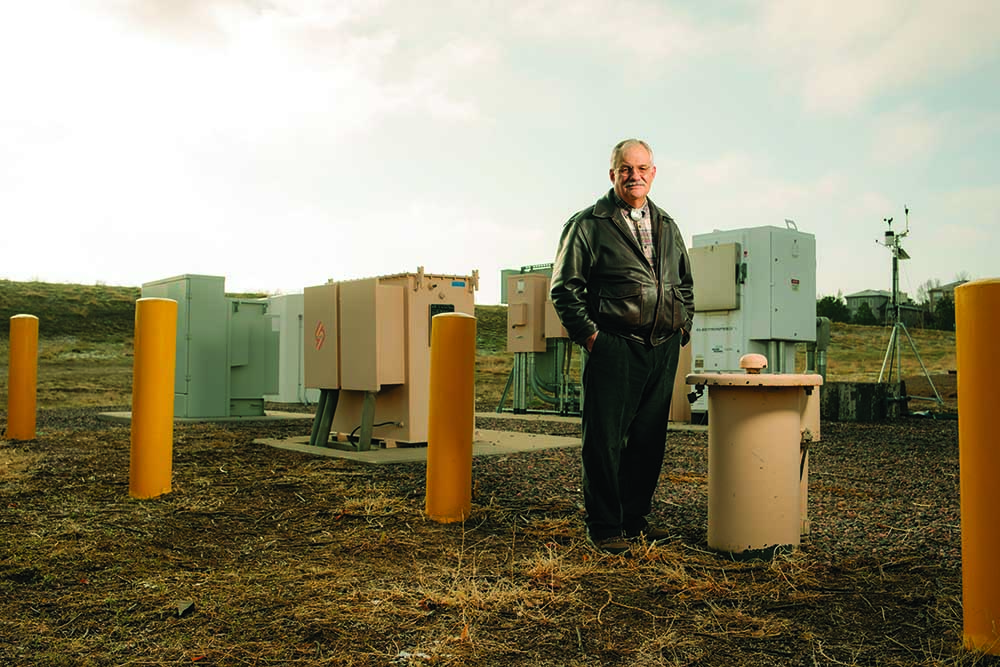As groundwater use declines, Colorado communities are testing new ways to store — not just extract — water from aquifers.
To dispel a myth circulating among residents that the groundwater they rely on is running dry, Castle Rock sent a flier to 30,000 households that touts aquifer storage as part of a wholesale shift in the town’s water supply from nonrenewable aquifers to replenishable sources.
Like many fast-growing Colorado cities, Castle Rock is slowly weaning itself off finite groundwater resources. The town reduced its reliance on water that fills cracks and other openings in beds of rock by 30% in the last 25 years. It hopes to rely 100% on renewable surface water by 2065, turning to aquifers only in times of drought.
To build a sustainable supply, the town amped up conservation and reuse efforts and purchased additional water to park in nearby reservoirs. It’s also testing wells that allow it to inject treated stream water into aquifers during wet years and pull it back out in dry times. The process is known as aquifer storage and recovery, or ASR.
“Nature’s storage tanks — that’s what we call them,” says Hannah Branning, the town’s water quality regulatory compliance manager. Branning stood recently in a low-slung brick pump house next to several wells that pull water from the Denver and Arapahoe aquifers and send it to a nearby treatment plant. The system can be reversed, using a series of valves, to return treated water into the ground for storage.
Castle Rock is not alone. The West’s worst drought in 1,200 years, mounting expenses and environmental hurdles to build new reservoirs, and groundwater decline prompted a growing number of Front Range municipalities to investigate the vast potential for storing water underground. Hydrogeologic studies determined ground-water systems across the state could store some 175 million acre-feet of the precious resource — an amount that dwarfs what’s kept in reservoirs. Yet what the geology can hold and what Colorado water law allows are two different matters entirely.
About 13 ASR projects are now in various stages of development. These include a system operated by Highlands Ranch Water, which pioneered the use of aquifer storage in the Denver Basin. The agency injected 15,257 acre-feet into three aquifers from 1993 to 2023 – a fraction of what it stores in surface reservoirs. The agency continues to inject water when available and dips into its groundwater reserves during droughts and when its surface water treatment plant cannot meet demand, Rick McLoud, water resources manager said in a presentation at the water storage symposium in February 2024.
Others, such as the South Metro Water Supply Authority, are researching how members might, during times of drought, share water banked underground in wet years. Such systems, unlike surface reservoirs, do not incur evaporative losses, aren’t exposed to pollution, are significantly cheaper to build, as well as scalable, and are readily available when needed.
Yet Colorado’s complicated water rights system is hindering growth of the promising technology. Other states are further ahead, with larger and more comprehensive systems in California, Arizona, Texas and Florida. ASR nationwide has been used to reduce seawater intrusion, as well as ground subsidence, and to store treated wastewater. Many of these projects are substantially larger than those in Colorado, with the San Antonio Water System clocking 144,525 acre-feet stored in the Edwards aquifer as of December 2024.
Colorado has “the strictest groundwater administration in the world,” says Dave Colvin, a hydrogeologist for the engineering consultancy firm LRE Water. “It does lead to limitations on using groundwater.”
The legal status of each groundwater basin directs policies for ASR implementation, Kevin Donegan, chief of the Hydrogeology Section at the Colorado Division of Water Resources, wrote in an email. Specific rules exist for aquifers that are not connected to surface water, known as non-tributary aquifers — this includes areas in the Denver Basin. Water can be stored indefinitely in these aquifers, which are nonrenewable. In other regions, water operators must complete an extensive scientific analysis to prove that a formation is not connected to surface water, he added.
Regions with little surface water that rely on groundwater, known as designated basins, also have their own ASR rules.
Outside of the designated basins, ASR is allowed in tributary, or alluvial, systems, which are connected to surface water, Donegan wrote, but “a decree or substitute water supply plan is needed to use the recharged water that surfaces at the stream.”
ASR’s expansion in Colorado is also stymied by a lack of sufficient water to store underground and infrastructure to store it with, as well as water quality concerns. Several agencies regulate its use, including the Environmental Protection Agency, which issues injection permits and requires testing to determine if injecting water into an aquifer alters water quality. The State of Colorado must also issue a permit.
Aquifer storage is not meant to replace the use of reservoirs, says Tom Sale, a hydrogeologist and emeritus professor of civil and environmental engineering at Colorado State University. Rather, the systems work together to help communities transition from pumping water out of nonrenewable aquifers to instead using sustainable surface water.
And, as the town of Castle Rock is discovering, this unprecedented change is difficult for Coloradans to fully grasp.
“It’s a paradigm shift in the thinking,” says Courtney Hemenway, consulting engi-neer at Hemenway Groundwater Engineering, Inc. “Mostly everything has been surface water related for storage — when you put it underground, you can’t see it, you can’t float a boat on it – there isn’t a limitation on ASR.”
Award-winning freelance journalist Jennifer Oldham’s pieces appear in National Geographic, The Center for Investigative Reporting, The Washington Post, among others.


 Print
Print